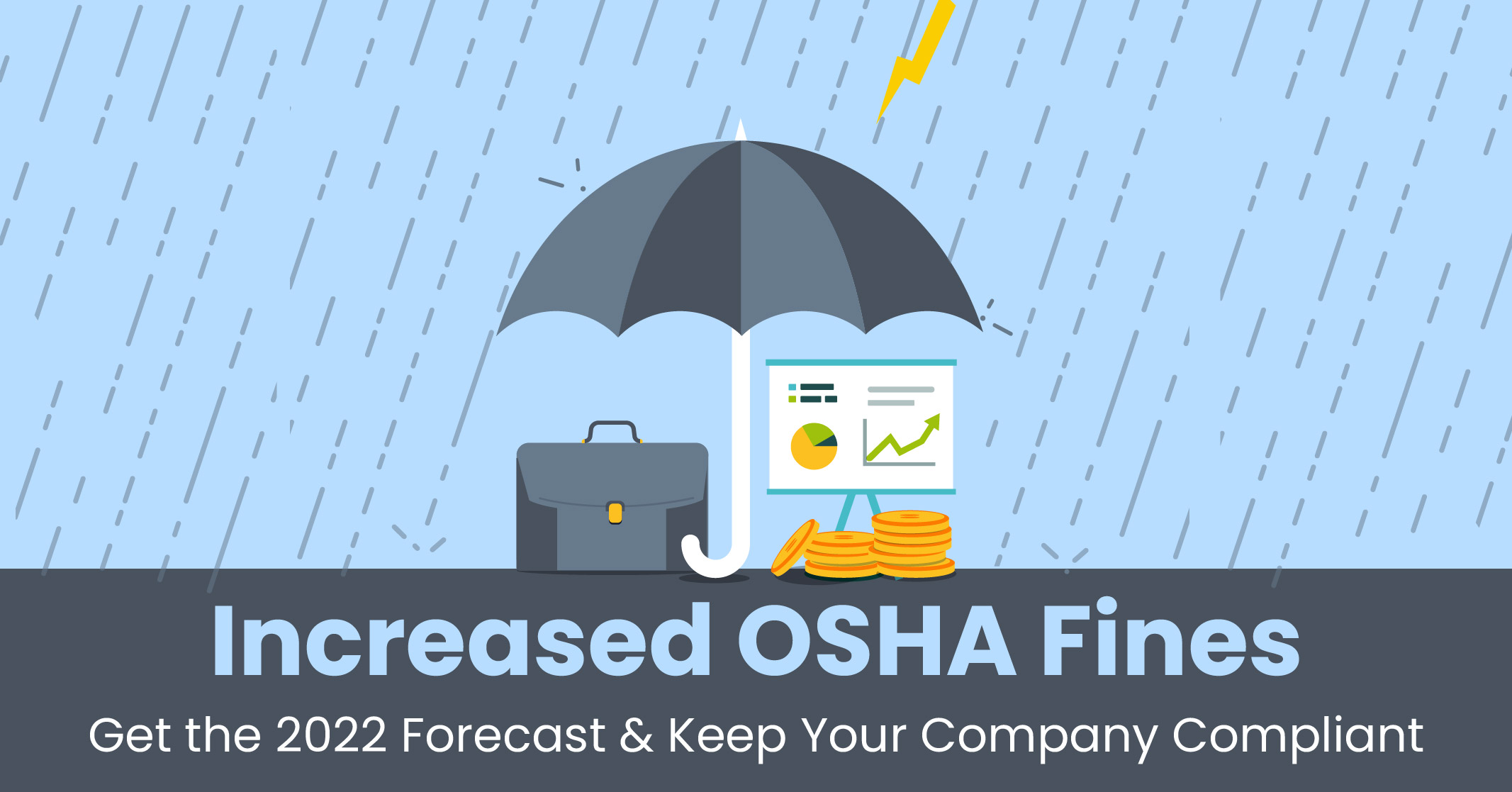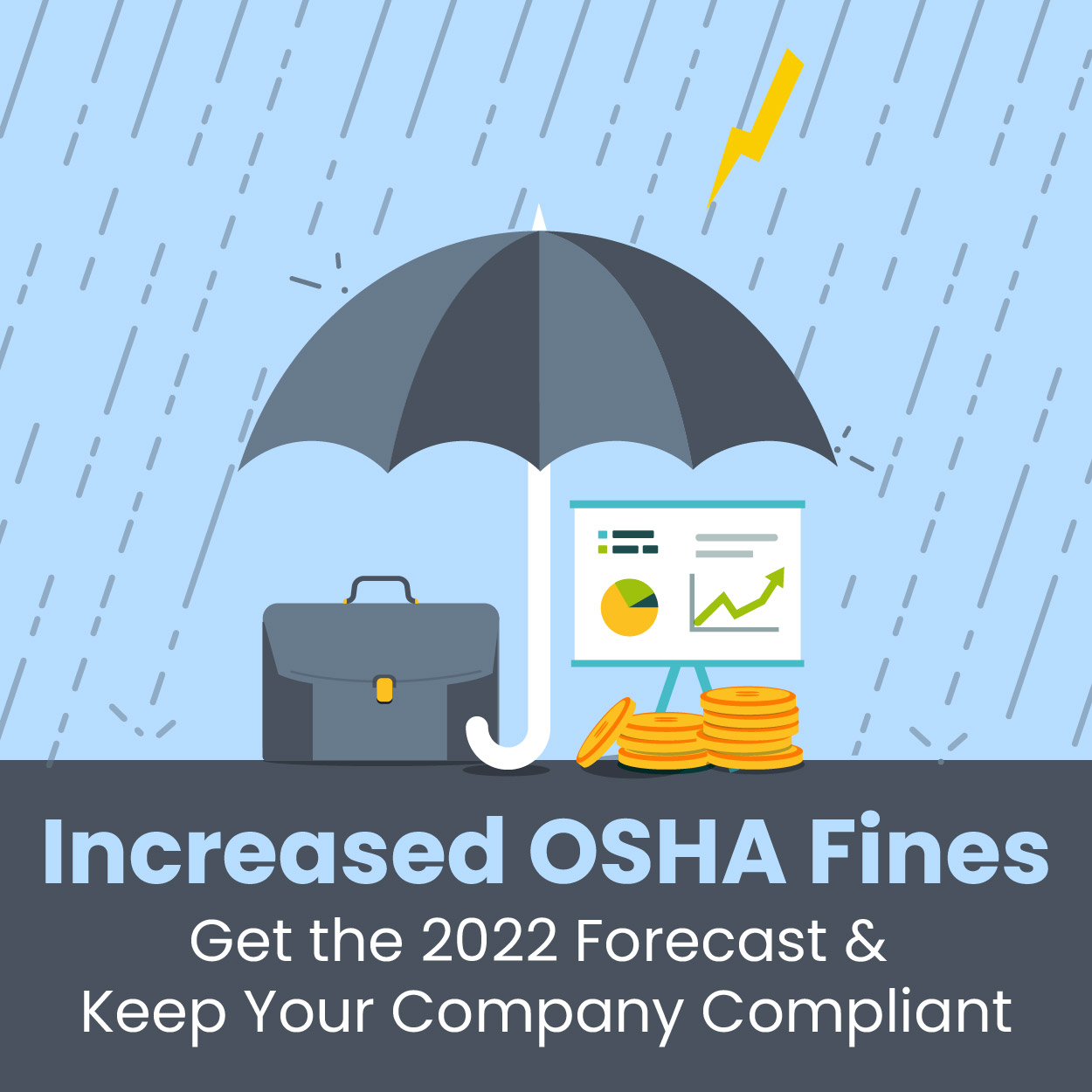
What Businesses Need to Know About OSHA Violations & Increased Fines in 2022
Whether you’re a business owner, a compliance officer, or a manager, it’s a safe bet that workplace safety is one of your top concerns. You’re probably also worried about keeping up with the latest Occupational Safety and Health Administration regulations so that your business doesn’t get penalized.
If you’re struggling to stay on top of all the changing rules, don’t worry. This blog will delve into the types of OSHA violations, the possible penalties, and the most recent fine increases. Safety issues are coming more under the microscope as employees and societal pressure pushes for increasingly better working conditions for team members.
What is OSHA’s Role?
OSHA was created by an act of Congress in 1970. It is tasked with making sure that workers have safe, healthy working conditions. OSHA sets safety standards and enforces them, usually by imposing fines for violations. The administration also provides training and educational services to improve real-world job safety.
OSHA covers most private sector workplaces, as well as federal agencies. State employees are indirectly covered by OSHA regulations as well.
Why Are OSHA Regulations Constantly Changing?
Sometimes, it can feel like OSHA’s rules and regulations are a moving target. And in fact, the administration routinely reviews its standards to make sure that they are staying relevant in the modern workplace. As businesses incorporate new industrial technology into the workplace, OSHA finds new ways to regulate that technology.
There are a number of things that can trigger new OSHA regulations. A different federal body — like the Secretary of Health and Human Services or the National Institute for Occupational Safety and Health — can ask OSHA to set new standards. State and local governments, or labor unions, can also request new standards. OSHA can also set new standards on its own initiative.
What Are Some of the Most Common OSHA Violations?
According to OSHA, the most common OSHA violations in 2021 were related to:
- Fall protection (general requirements)
- Respiratory protection
- Ladders
- Scaffolding
- Hazard communication standards
- Control of hazardous energy
- Fall protection (training)
- Eye and face protection
- Powered industrial trucks
- Machinery and machine guarding
OSHA says that the best way to prevent on-the-job injuries is to improve safety training for all employees. It also helps to stay aware of the most common violations so that you can be sure to be prepared for what OSHA will most likely keep an eye out for and plan employee training accordingly. When safety protocols are implemented and tested, the chance of injury decreases along with daily operations experiencing improved outcomes.
What Are the Reasons an Organization Should Remain as Close to 100% Compliant as Possible?
Every business has a vested interest in keeping its workers safe. That means following common-sense safety protocols and making sure that your employees have access to the training and protective equipment they need.
There are other reasons to stay compliant with OSHA, though. The administration imposes stiff penalties for violating its standards. If your business gets hit with an OSHA fine, your bottom line could take a serious hit.
If your violation is considered “willful,” you could be looking at fines of more than $145,000 per violation. Or if you are a repeat violator, you could face fines of $14,500 for each day that you are in violation of an OSHA regulation.
Depending on how much of a margin you have built into your budget, you could find it impossible to stay up and running after being found in violation of a few OSHA regulations.
Types of OSHA Violations to Be Aware Of
There’s a long list of OSHA standards, and it’s important to stay aware of each of them. Working with the right partner can also help you make sure that you don’t get caught out of compliance.
But it’s also important to understand the way that OSHA classifies violations. The organization penalizes business owners based on how severe and repeated the violations are. The types of OSHA violations are as follows.
Willful
This is the most severe category of OSHA violation. OSHA classifies a violation as willful if a business is aware of the regulations but has intentionally disregarded them. Employers can also be found to be in willful violation if they display indifference to their employees’ health and safety.
OSHA’s penalties have recently increased. As of 2022, the minimum penalty for a willful violation is $10,360. The maximum penalty is $145,027. If a business is found to have violated multiple OSHA standards, it could be fined separately for each violation.
In most cases, violations will be penalized with fines. However, if a willful violation results in the death of an employee, then the at-fault employer may face up to six months of imprisonment. They may still face a fine on top of their prison time. Repeat offenders may face up to a year of imprisonment for violations that result in the death of an employee.
Serious
OSHA considers a violation to be serious if there is a “substantial probability” that it could lead to a death or a major injury. In general, employers are expected to exercise their due diligence and stay informed about all serious violations in the workplace.
According to the OSHA Act, “A serious violation shall be deemed to exist in a place of employment if there is a substantial probability that death or serious physical harm could result from a condition which exists, or from one or more practices, means, methods, operations, or processes which have been adopted or are in use, in such place of employment unless the employer did not, and could not with the exercise of reasonable diligence, know of the presence of the violation.”
In 2022, OSHA began imposing penalties of $14,502 for each serious violation.
Other Than Serious
The other-than-serious category covers hazards that are unlikely to lead to a death or a serious injury but may still impact the health and safety of employees. OSHA may also impose penalties for other-than-serious violations. Those penalties are $14,502 per violation.
De Minimis
OSHA will not charge fines or issue penalties as a result of a de minimus violation. A de minimus violation is one that does not directly impact the health or safety of employees.
De minimus means that an employer has complied with the spirit of the OSHA regulations but has not followed the exact letter of the law; in other words, the employer has deviated from some detail of the regulations, but the result will not endanger employees’ health or safety.
Failure to Abate
After OSHA inspects and finds a violation, it offers the business a fixed amount of time in which the business must meet compliance standards. When the inspector returns, an audit is completed to see whether the same hazard has been adequately addressed.
If the business has not corrected the hazardous condition, then OSHA will issue a “failure to abate” violation. Failure to abate can result in penalties of $14,502 per day, beginning at the abatement date.
Repeated
OSHA may cite an employer for a repeated violation if that employer has been cited in the past five years, either for the same violation or for a “substantially similar” hazardous condition.
OSHA may impose a penalty of $145,502 for each repeated violation.
Fine Increases for 2022 and What They Mean
OSHA increased all of its fines in 2022. Here’s what that means for your business.
What Are the New Fine Amounts, and What Were the Old Fine Amounts?
| Type of Violation | 2021 Maximum Penalty Amount | 2022 Maximum Penalty Amount |
|---|---|---|
| “Serious or other-than-serious”” | $13,653 | $14,502 |
| “Willful or repeated penalty” | $135,532 | $145,027 |
| “Failure-to-abate” | $13,653 | $14,502 |
What Is the Purpose of the Increases?
OSHA reassesses its penalties every year in order to keep up with inflation and the rising cost of living. It looks at the Consumer Price Index and determines a cost-of-living adjustment multiplier. For 2022, that multiplier was 1.06222; the administration multiplied its existing penalties by that figure and then rounded up.
What Does This Mean for Businesses?
Now that the penalties have increased, businesses need to be even more careful to avoid violations and stay compliant with OSHA regulations.
It’s a good idea to put an additional emphasis on safety and communicate that to all employees. In the same vein, regular training on new and old protocols should be conducted throughout the workplace so that every employee is aware of the rules and regulations.
Businesses should treat safety as a business investment, and not as a financial burden. Avoiding a massive OSHA fine is more than enough of an incentive for staying safe and keeping the workplace within compliance standards.
For that reason, it’s a good idea to consider hiring a safety director or compliance officer in 2022. Sometimes, business owners want to avoid the expense of hiring a new employee or paying for a third-party review. But in fact, a compliance officer’s yearly salary could be surpassed by just a few OSHA fines.
How to Best Avoid OSHA Violations
Working with an experienced and skilled compliance officer is the best way to avoid all the different types of OSHA violations. YellowBird can help you find the right expert to help your business.
YellowBird matches businesses in a variety of sectors with environmental, health and safety professionals. Join the YellowBird platform and post what you’re looking for. We will match you with an EHS professional who has the skills, experience, and qualifications necessary to meet your organizational goals and safety concerns. Get started today!





